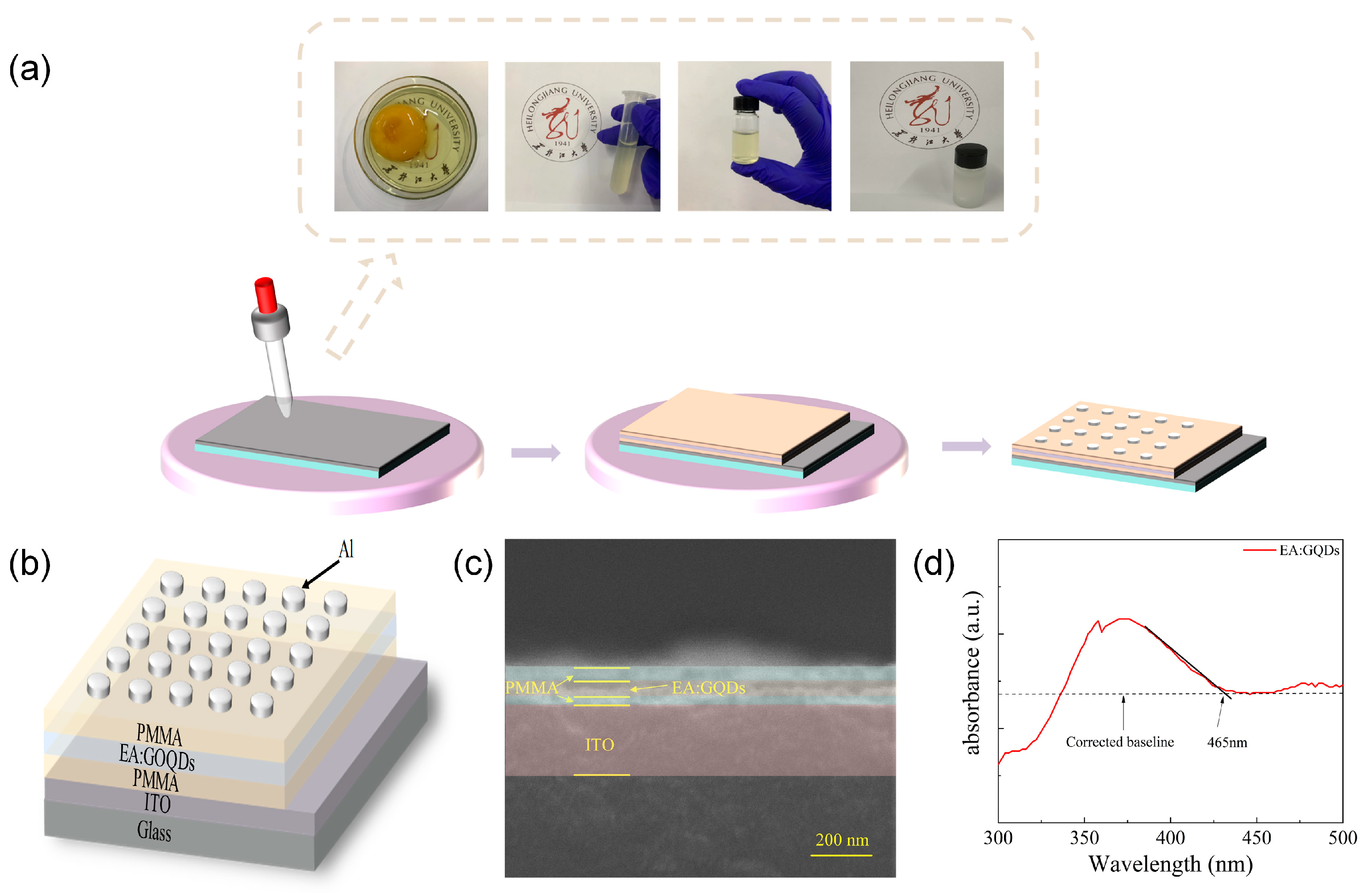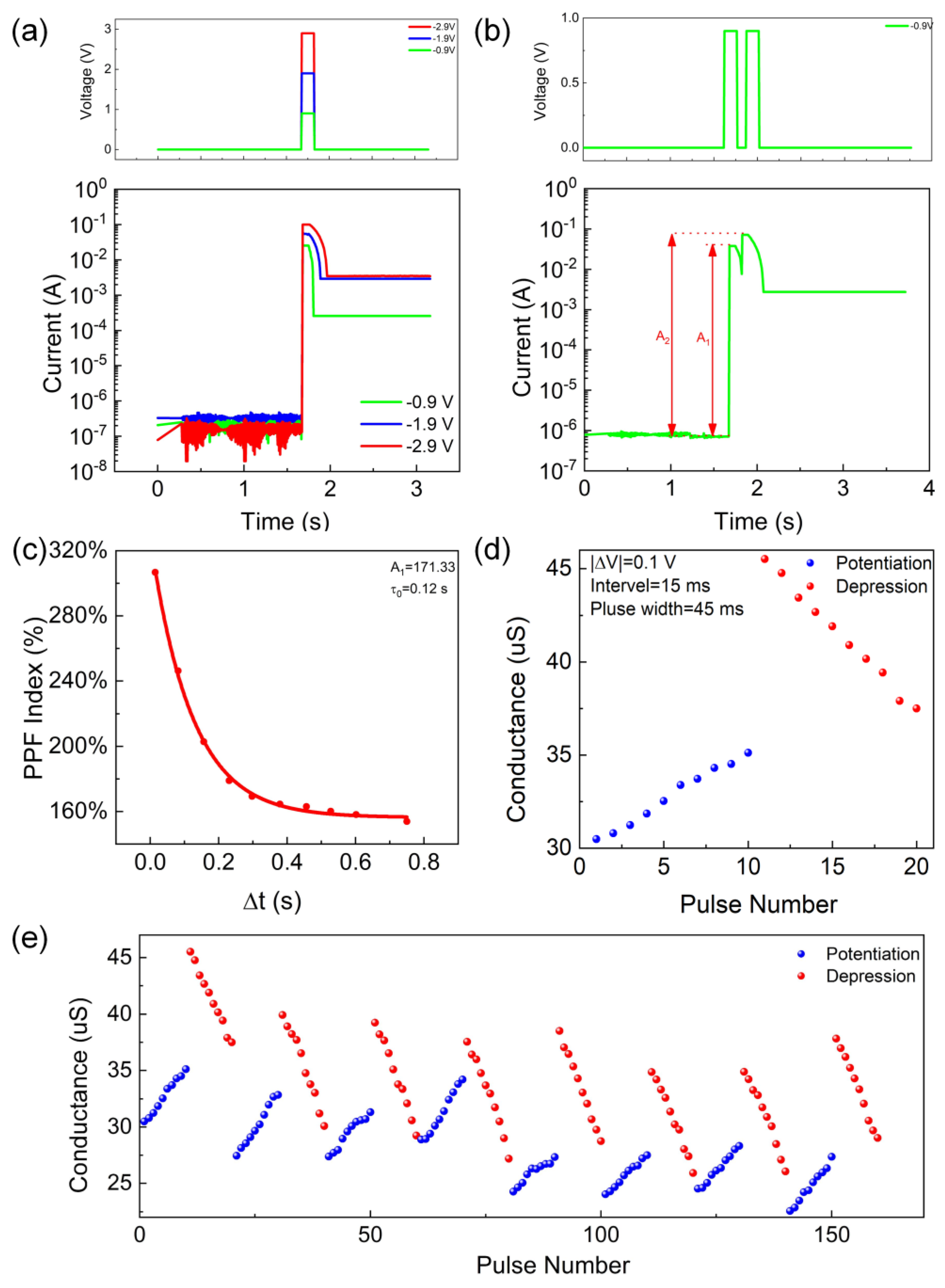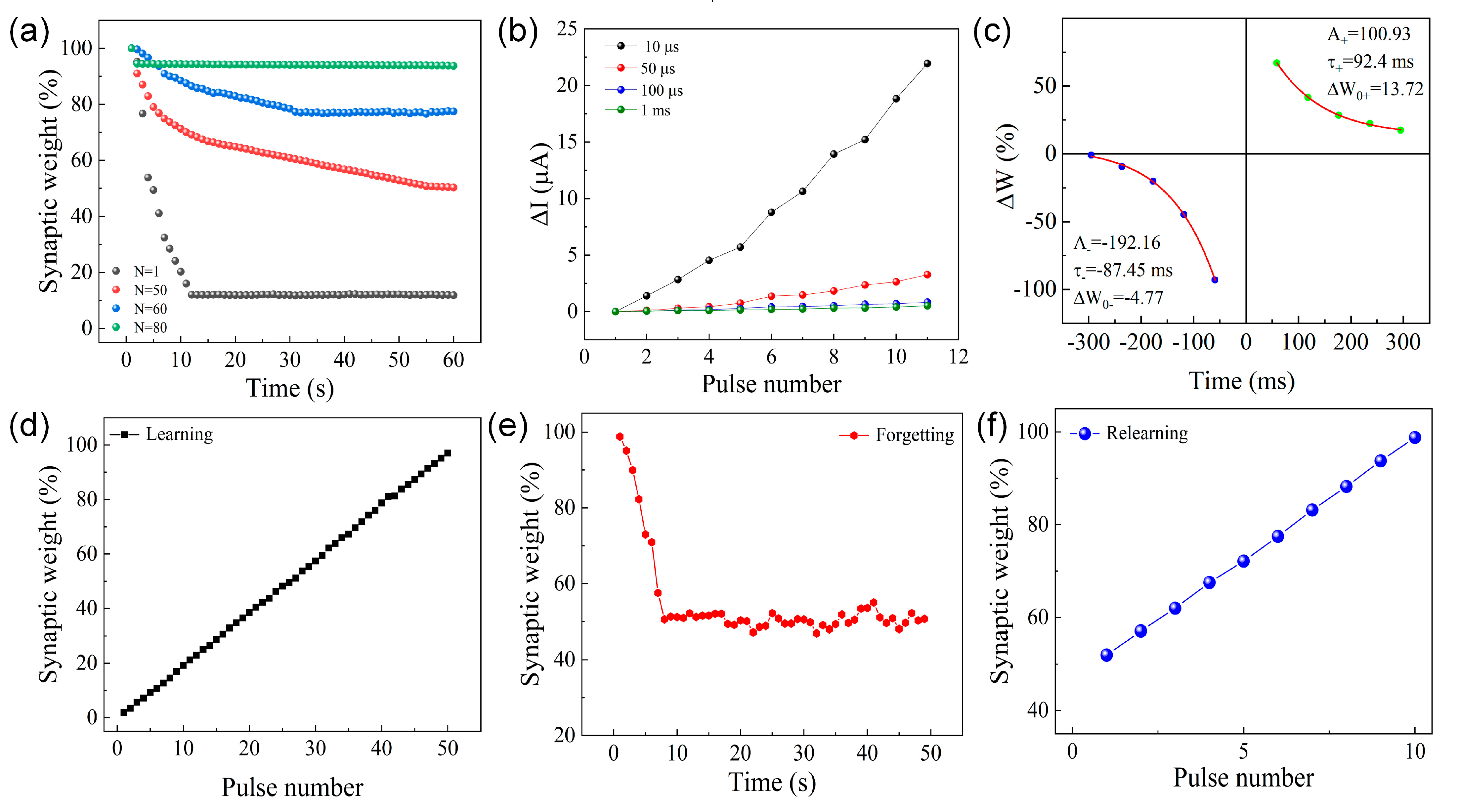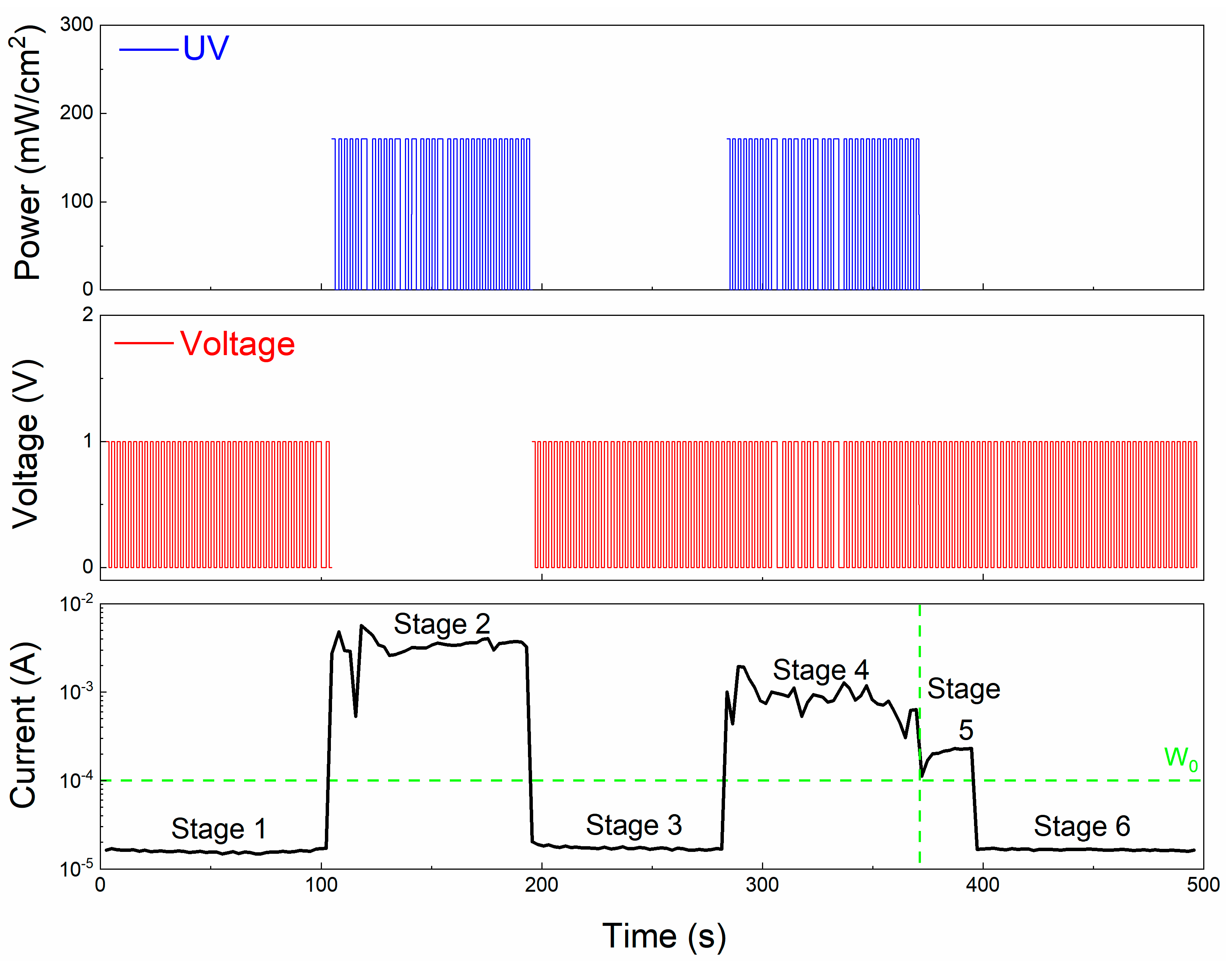Artificial Synapses Based on an Optical/Electrical Biomemristor
Abstract
:1. Introduction
2. Materials and Methods
2.1. Device Fabrication
2.2. Instrument
3. Results
4. Conclusions
Author Contributions
Funding
Data Availability Statement
Conflicts of Interest
References
- Merolla, P.A.; Arthur, J.V.; Alvarez-Icaza, R.; Cassidy, A.S.; Sawada, J.; Akopyan, F.; Jackson, B.L.; Imam, N.; Guo, C.; Nakamura, Y.; et al. Artificial brains. A million spiking-neuron integrated circuit with a scalable communication network and interface. Science 2014, 345, 668–673. [Google Scholar] [CrossRef] [PubMed]
- Sheridan, P.M.; Cai, F.; Du, C.; Ma, W.; Zhang, Z.; Lu, W.D. Sparse coding with memristor networks. Nat. Nanotechnol. 2017, 12, 784–789. [Google Scholar] [CrossRef] [PubMed]
- Jeong, D.S.; Kim, K.M.; Kim, S.; Choi, B.J.; Hwang, C.S. Memristors for Energy-Efficient New Computing Paradigms. Adv. Electron. Mater. 2016, 2, 1600090. [Google Scholar] [CrossRef]
- Jo, S.H.; Chang, T.; Ebong, I.; Bhadviya, B.B.; Mazumder, P.; Lu, W. Nanoscale memristor device as synapse in neuromorphic systems. Nano Lett. 2010, 10, 1297–1301. [Google Scholar] [CrossRef] [PubMed]
- Zhao, C.; Cheung, C.F.; Xu, P. High-efficiency submicroscale uncertainty measurement method using pattern recognition. ISA Trans. 2020, 101, 503–514. [Google Scholar] [CrossRef] [PubMed]
- Yu, S.; Wu, Y.; Jeyasingh, R.; Kuzum, D.; Wong, H.S.P. An Electronic Synapse Device Based on Metal Oxide Resistive Switching Memory for Neuromorphic Computation. IEEE Trans. Electron Devices 2011, 58, 2729–2737. [Google Scholar] [CrossRef]
- Wang, Z.; Yin, M.; Zhang, T.; Cai, Y.; Wang, Y.; Yang, Y.; Huang, R. Engineering incremental resistive switching in TaOx based memristors for brain-inspired computing. Nanoscale 2016, 8, 14015–14022. [Google Scholar] [CrossRef]
- Prezioso, M.; Merrikh-Bayat, F.; Hoskins, B.D.; Adam, G.C.; Likharev, K.K.; Strukov, D.B. Training and operation of an integrated neuromorphic network based on metal-oxide memristors. Nature 2015, 521, 61–64. [Google Scholar] [CrossRef]
- Yang, J.J.; Strukov, D.B.; Stewart, D.R. Memristive devices for computing. Nat. Nanotechnol. 2013, 8, 13–24. [Google Scholar] [CrossRef]
- Pan, F.; Gao, S.; Chen, C.; Song, C.; Zeng, F. Recent progress in resistive random access memories: Materials, switching mechanisms, and performance. Mater. Sci. Eng. R Rep. 2014, 83, 1–59. [Google Scholar] [CrossRef]
- Rajendran, B.; Liu, Y.; Seo, J.-s.; Gopalakrishnan, K.; Chang, L.; Friedman, D.J.; Ritter, M.B. Specifications of Nanoscale Devices and Circuits for Neuromorphic Computational Systems. IEEE Trans. Electron Devices 2013, 60, 246–253. [Google Scholar] [CrossRef]
- Park, Y.; Lee, J.S. Artificial Synapses with Short- and Long-Term Memory for Spiking Neural Networks Based on Renewable Materials. ACS Nano 2017, 11, 8962–8969. [Google Scholar] [CrossRef] [PubMed]
- Li, S.; Zeng, F.; Chen, C.; Liu, H.; Tang, G.; Gao, S.; Song, C.; Lin, Y.; Pan, F.; Guo, D. Synaptic plasticity and learning behaviors mimicked through Ag interface movement in an Ag/conducting polymer/Ta memristive system. J. Mater. Chem. C 2013, 1, 5292–5298. [Google Scholar] [CrossRef]
- Hu, S.G.; Liu, Y.; Chen, T.P.; Liu, Z.; Yu, Q.; Deng, L.J.; Yin, Y.; Hosaka, S. Emulating the Ebbinghaus forgetting curve of the human brain with a NiO-based memristor. Appl. Phys. Lett. 2013, 103, 133701. [Google Scholar] [CrossRef]
- Li, J.; Duan, Q.; Zhang, T.; Yin, M.; Sun, X.; Cai, Y.; Li, L.; Yang, Y.; Huang, R. Tuning analog resistive switching and plasticity in bilayer transition metal oxide based memristive synapses. RSC Adv. 2017, 7, 43132–43140. [Google Scholar] [CrossRef]
- Lai, Q.; Zhang, L.; Li, Z.; Stickle, W.F.; Williams, R.S.; Chen, Y. Ionic/electronic hybrid materials integrated in a synaptic transistor with signal processing and learning functions. Adv. Mater. 2010, 22, 2448–2453. [Google Scholar] [CrossRef]
- Kuzum, D.; Jeyasingh, R.G.; Lee, B.; Wong, H.S. Nanoelectronic programmable synapses based on phase change materials for brain-inspired computing. Nano Lett. 2012, 12, 2179–2186. [Google Scholar] [CrossRef]
- Merolla/Yan, X.; Zhou, Z.; Ding, B.; Zhao, J.; Zhang, Y. Superior resistive switching memory and biological synapse properties based on a simple TiN/SiO2/p-Si tunneling junction structure. J. Mater. Chem. C 2017, 5, 2259–2267. [Google Scholar]
- Wang, Z.Q.; Xu, H.Y.; Li, X.H.; Yu, H.; Liu, Y.C.; Zhu, X.J. Synaptic Learning and Memory Functions Achieved Using Oxygen Ion Migration/Diffusion in an Amorphous InGaZnO Memristor. Adv. Funct. Mater. 2012, 22, 2759–2765. [Google Scholar] [CrossRef]
- Kim, S.; Kim, H.; Hwang, S.; Kim, M.H.; Chang, Y.F.; Park, B.G. Analog Synaptic Behavior of a Silicon Nitride Memristor. ACS Appl. Mater. Interfaces 2017, 9, 40420–40427. [Google Scholar] [CrossRef]
- Aziz, J.; Khan, M.F.; Neumaier, D.; Ahmad, M.; Kim, H.; Rehman, S.; Elahi, E.; Chavan, V.D.; Ghafoor, F.; Kadam, K.D.; et al. Improved memory performance of ALD grown HfO2 films by nitrogen doping. Mater. Sci. Eng. B 2023, 297, 116755. [Google Scholar] [CrossRef]
- Zhao, Y.Y.; Sun, W.J.; Wang, J.; He, J.H.; Li, H.; Xu, Q.F.; Li, N.J.; Chen, D.Y.; Lu, J.M. All-Inorganic Ionic Polymer-Based Memristor for High-Performance and Flexible Artificial Synapse. Adv. Funct. Mater. 2020, 30, 2004245. [Google Scholar] [CrossRef]
- Ren, C.; Zhong, G.; Xiao, Q.; Tan, C.; Feng, M.; Zhong, X.; An, F.; Wang, J.; Zi, M.; Tang, M.; et al. Highly Robust Flexible Ferroelectric Field Effect Transistors Operable at High Temperature with Low-Power Consumption. Adv. Funct. Mater. 2019, 30, 2070005. [Google Scholar] [CrossRef]
- Zhang, J.J.; Sun, H.J.; Li, Y.; Wang, Q.; Xu, X.H.; Miao, X.S. AgInSbTe memristor with gradual resistance tuning. Appl. Phys. Lett. 2013, 102, 183513. [Google Scholar] [CrossRef]
- Gupta, V.; Lucarelli, G.; Castro-Hermosa, S.; Brown, T.; Ottavi, M. Investigation of hysteresis in hole transport layer free metal halide perovskites cells under dark conditions. Nanotechnology 2020, 31, 445201. [Google Scholar] [CrossRef] [PubMed]
- Das, U.; Sarkar, P.; Paul, B.; Roy, A. Halide perovskite two-terminal analog memristor capable of photoactivated synaptic weight modulation for neuromorphic computing. Appl. Phys. Lett. 2021, 118, 182103. [Google Scholar] [CrossRef]
- Gogoi, H.J.; Bajpai, K.; Mallajosyula, A.T.; Solanki, A. Advances in Flexible Memristors with Hybrid Perovskites. J. Phys. Chem. Lett. 2021, 12, 8798–8825. [Google Scholar] [CrossRef]
- Wang, Y.; Liu, H.; Liu, P.; Lu, W.; Cui, J.; Chen, X.; Lu, M. Energy-efficient synaptic devices based on planar structured h-BN memristor. J. Alloys Compd. 2022, 909, 164775. [Google Scholar] [CrossRef]
- Rehman, S.; Khan, M.F.; Rahmani, M.K.; Kim, H.; Patil, H.; Khan, S.A.; Kang, M.H.; Kim, D.-K. Neuro-transistor based on uv-treated charge trapping in mote2 for artificial synaptic features. Nanomaterials 2020, 10, 2326. [Google Scholar] [CrossRef]
- Song, Y.-W.; Song, M.-K.; Choi, D.; Kwon, J.-Y. Encapsulation-enhanced switching stability of MoS2 memristors. J. Alloys Compd. 2021, 885, 161016. [Google Scholar] [CrossRef]
- Hwang, S.W.; Tao, H.; Kim, D.H.; Cheng, H.; Song, J.K.; Rill, E.; Brenckle, M.A.; Panilaitis, B.; Won, S.M.; Kim, Y.S.; et al. A physically transient form of silicon electronics. Science 2012, 337, 1640–1644. [Google Scholar] [CrossRef] [PubMed]
- Dagdeviren, C.; Hwang, S.W.; Su, Y.; Kim, S.; Cheng, H.; Gur, O.; Haney, R.; Omenetto, F.G.; Huang, Y.; Rogers, J.A. Transient, biocompatible electronics and energy harvesters based on ZnO. Small 2013, 9, 3398–3404. [Google Scholar] [CrossRef] [PubMed]
- Hwang, S.-W.; Kim, D.-H.; Tao, H.; Kim, T.-i.; Kim, S.; Yu, K.J.; Panilaitis, B.; Jeong, J.-W.; Song, J.-K.; Omenetto, F.G.; et al. Materials and Fabrication Processes for Transient and Bioresorbable High-Performance Electronics. Adv. Funct. Mater. 2013, 23, 4087–4093. [Google Scholar] [CrossRef]
- Ji, Y.; Cho, B.; Song, S.; Kim, T.W.; Choe, M.; Kahng, Y.H.; Lee, T. Stable switching characteristics of organic nonvolatile memory on a bent flexible substrate. Adv. Mater. 2010, 22, 3071–3075. [Google Scholar] [CrossRef] [PubMed]
- Liu, G.; Wang, C.; Zhang, W.; Pan, L.; Zhang, C.; Yang, X.; Fan, F.; Chen, Y.; Li, R.-W. Organic Biomimicking Memristor for Information Storage and Processing Applications. Adv. Electron. Mater. 2016, 2, 1500298. [Google Scholar] [CrossRef]
- Chung, T.H.; Dhar, B.R. Paper-based platforms for microbial electrochemical cell-based biosensors: A review. Biosens. Bioelectron. 2021, 192, 113485. [Google Scholar] [CrossRef]
- Chang, J.W.; Wang, C.G.; Huang, C.Y.; Tsai, T.D.; Guo, T.F.; Wen, T.C. Chicken albumen dielectrics in organic field-effect transistors. Adv. Mater. 2011, 23, 4077–4081. [Google Scholar] [CrossRef]
- Wu, W.; Han, S.T.; Venkatesh, S.; Sun, Q.; Peng, H.; Zhou, Y.; Yeung, C.; Li, R.K.Y.; Roy, V.A.L. Biodegradable skin-inspired nonvolatile resistive switching memory based on gold nanoparticles embedded alkali lignin. Org. Electron. 2018, 59, 382–388. [Google Scholar] [CrossRef]
- Sun, B.; Zhang, X.; Zhou, G.; Li, P.; Zhang, Y.; Wang, H.; Xia, Y.; Zhao, Y. An organic nonvolatile resistive switching memory device fabricated with natural pectin from fruit peel. Org. Electron. 2017, 42, 181–186. [Google Scholar] [CrossRef]
- Yu, F.; Zhu, L.Q.; Gao, W.T.; Fu, Y.M.; Xiao, H.; Tao, J.; Zhou, J.M. Chitosan-based polysaccharide-gated flexible indium tin oxide synaptic transistor with learning abilities. ACS Appl. Mater. Interfaces 2018, 10, 16881–16886. [Google Scholar] [CrossRef]
- Sun, B.; Guo, T.; Zhou, G.; Wu, J.; Chen, Y.; Zhou, Y.N.; Wu, Y.A. A battery-like self-selecting biomemristor from earth-abundant natural biomaterials. ACS Appl. Bio Mater. 2021, 4, 1976–1985. [Google Scholar] [CrossRef] [PubMed]
- Yan, X.; Li, X.; Zhou, Z.; Zhao, J.; Wang, H.; Wang, J.; Zhang, L.; Ren, D.; Zhang, X.; Chen, J.; et al. Flexible transparent organic artificial synapse based on the tungsten/egg albumen/indium tin oxide/polyethylene terephthalate memristor. ACS Appl. Mater. Interfaces 2019, 11, 18654–18661. [Google Scholar] [CrossRef]
- Zhou, G.; Ren, Z.; Wang, L.; Sun, B.; Duan, S.; Song, Q. Artificial and wearable albumen protein memristor arrays with integrated memory logic gate functionality. Mater. Horiz. 2019, 6, 1877–1882. [Google Scholar] [CrossRef]
- Sung, S.; Park, J.H.; Wu, C.; Kim, T.W. Biosynaptic devices based on chicken egg albumen: Graphene quantum dot nanocomposites. Sci. Rep. 2020, 10, 1255. [Google Scholar] [CrossRef] [PubMed]
- Ghosh, T.; Kandpal, S.; Pathak, D.K.; Tanwar, M.; Rani, C.; Chaudhary, A.; Kumar, R. Aloe vera flower extract as a botanical resistive memory element: A natural memristor! ACS Appl. Electron. Mater. 2021, 3, 1556–1559. [Google Scholar] [CrossRef]
- Saha, M.; Nawaz, S.M.; Keshari, B.K.; Mallik, A. Natural-casein-based biomemristor with pinched current–voltage characteristics. ACS Appl. Bio Mater. 2022, 5, 833–840. [Google Scholar] [CrossRef]
- Wang, L.; Zhang, Y.; Zhang, P.; Wen, D. Flexible Transient Resistive Memory Based on Biodegradable Composites. Nanomaterials 2022, 12, 3531. [Google Scholar] [CrossRef]
- Wang, L.; Yang, T.; Wen, D. Tunable multilevel data storage bioresistive random access memory device based on egg albumen and carbon nanotubes. Nanomaterials 2021, 11, 2085. [Google Scholar] [CrossRef]
- Wang, L.; Zhu, H.; Wen, D. Bioresistive random-access memory with gold nanoparticles that generate the coulomb blocking effect can realize multilevel data storage and synapse simulation. J. Phys. Chem. Lett. 2021, 12, 8956–8962. [Google Scholar] [CrossRef]
- Wang, L.; Wei, S.; Xie, J.; Wen, D. Bioartificial Synapses for Neuromorphic Computing. ACS Sustain. Chem. Eng. 2023, 11, 2229–2237. [Google Scholar] [CrossRef]






Disclaimer/Publisher’s Note: The statements, opinions and data contained in all publications are solely those of the individual author(s) and contributor(s) and not of MDPI and/or the editor(s). MDPI and/or the editor(s) disclaim responsibility for any injury to people or property resulting from any ideas, methods, instructions or products referred to in the content. |
© 2023 by the authors. Licensee MDPI, Basel, Switzerland. This article is an open access article distributed under the terms and conditions of the Creative Commons Attribution (CC BY) license (https://creativecommons.org/licenses/by/4.0/).
Share and Cite
Wang, L.; Wei, S.; Xie, J.; Ju, Y.; Yang, T.; Wen, D. Artificial Synapses Based on an Optical/Electrical Biomemristor. Nanomaterials 2023, 13, 3012. https://doi.org/10.3390/nano13233012
Wang L, Wei S, Xie J, Ju Y, Yang T, Wen D. Artificial Synapses Based on an Optical/Electrical Biomemristor. Nanomaterials. 2023; 13(23):3012. https://doi.org/10.3390/nano13233012
Chicago/Turabian StyleWang, Lu, Shutao Wei, Jiachu Xie, Yuehang Ju, Tianyu Yang, and Dianzhong Wen. 2023. "Artificial Synapses Based on an Optical/Electrical Biomemristor" Nanomaterials 13, no. 23: 3012. https://doi.org/10.3390/nano13233012
APA StyleWang, L., Wei, S., Xie, J., Ju, Y., Yang, T., & Wen, D. (2023). Artificial Synapses Based on an Optical/Electrical Biomemristor. Nanomaterials, 13(23), 3012. https://doi.org/10.3390/nano13233012





